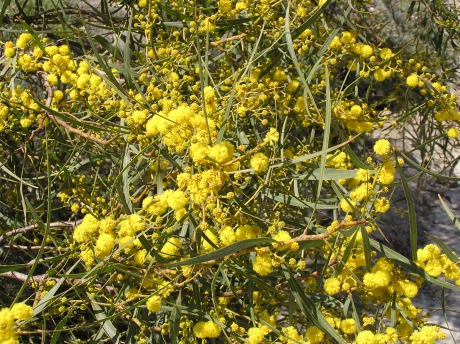zurück Rhodos
Blumen
last
Blumen 6
next

Rhodos: Mimosenbaum (horesti)
The Mimosa
tree (Mimosa pudica) is a
tropical plant known for its sensitive
leaves and beautiful, fluffy, pink flowers. While the term
"Mimosa" can refer to several
species within the Mimosa genus, the
one most commonly associated with the name, especially in popular culture, is
Mimosa pudica, which is also
known as the sensitive plant or
touch-me-not due to its unique
ability to respond to touch.
However, there are also other species
commonly referred to as Mimosa,
like the Silk Tree (Albizia
julibrissin), which is often grown for its ornamental value and has similar
characteristics in terms of its beautiful flowers.
Mimosa Tree (Mimosa pudica) – Key Features:
1.
Sensitive Leaves (Mimosa pudica):
-
Sensitive or Touch-Me-Not:
The most unique feature of Mimosa
pudica is its ability to rapidly fold up its leaves when touched,
shaken, or exposed to other stimuli. This movement is called
nyctinasty, and it's a
defense mechanism against herbivores, as it makes the plant appear smaller
and less palatable.
-
Leaflets: The leaves are
compound, with
small leaflets that fold
inward when disturbed, creating a "closed" effect.
-
Appearance: The leaves
are bright green and pinnately
compound, meaning each leaf is made up of smaller leaflets arranged
on either side of a central stem.
2. Flowers:
-
Pink or Purple Puffball Flowers:
The flowers of
Mimosa pudica are small
and fluffy, usually
pink or purple in color.
They grow in spherical clusters and are often compared to the "puffs" of a
dandelion or a small, colorful pom-pom.
-
Fragrant: The flowers are
mildly fragrant and add
an ornamental touch to the plant when in bloom.
3. Growth Habit and Size:
-
Shrubby or Small Tree Form:
Mimosa pudica is typically a low-growing, shrubby plant, but in warm
tropical areas, it can grow up to
1-3 feet (30-90 cm) in height. In certain conditions, it can grow
into a small tree or bush.
-
Tropical and Subtropical Regions:
Native to South and Central
America, it thrives in warm climates and is often cultivated in
tropical and
subtropical areas
worldwide.
4. Habitat and Distribution:
- Mimosa pudica is native to
tropical and subtropical regions
of South and Central America
but has spread to other areas as an ornamental plant. It is
widely distributed in
parts of Asia,
Africa, and
the Pacific Islands, and
in some regions, it is even considered an invasive species.
5. Uses:
-
Medicinal Uses: In some
traditional medicines, Mimosa pudica is believed to have
medicinal properties.
It's sometimes used in herbal treatments for issues like
wounds,
fevers,
skin infections, and
digestive problems.
However, the plant is not commonly used in modern Western medicine.
-
Ornamental: The plant is
often cultivated for ornamental purposes because of its
beautiful flowers and
interesting leaf movements.
6. Care and Growth:
-
Light Requirements:
Mimosa pudica grows best in full
sun to partial shade.
It thrives in bright, warm environments.
-
Watering: The plant
prefers well-drained soil
and regular watering but doesn’t like to stay soggy. It should be watered
when the top layer of the soil feels dry.
-
Temperature: Being a
tropical plant, it does best in temperatures above
15°C (59°F), and it will
not survive in frost.
-
Soil: Well-drained,
fertile soil is ideal for this plant, and it should not be overwatered.
7. Mimosa (Silk Tree) - Albizia
julibrissin:
-
Appearance: The
Silk Tree (or
Albizia julibrissin) is
another tree often referred to as a mimosa. It has a
distinctive appearance
with feathery, fern-like leaves
and large silky, pink flowers
that resemble puffs of silk. The flowers are usually
pink and appear in late
spring to summer.
-
Size: The Silk Tree is
typically larger, growing up to
20-40 feet (6-12 meters) tall with a wide canopy.
-
Uses: It's grown
primarily for its ornamental value
in parks and gardens. The flowers are attractive to pollinators like bees
and butterflies, making the plant beneficial for local wildlife.
-
Invasiveness: In some
areas, particularly in the U.S., the
Silk Tree is considered
invasive and can
outcompete native species in disturbed areas.
In Conclusion:
The Mimosa tree can refer to
either the sensitive plant (Mimosa
pudica) or the Silk Tree
(Albizia julibrissin), both of which
are known for their distinctive features and ornamental value. The
sensitive plant is famous for
its reactive leaves, which
fold up when touched, while the Silk
Tree is appreciated for its
beautiful pink flowers and feathery foliage. Both plants add aesthetic
value to gardens and landscapes but require warm climates to thrive.
 26.07.25 Copyright Dirk
Rauschenbach Koelnerstrasse 293 51702 Bergneustadt
Datenschutzerklaerung 02261 9788972 Mail ccooly(
at) web.de
26.07.25 Copyright Dirk
Rauschenbach Koelnerstrasse 293 51702 Bergneustadt
Datenschutzerklaerung 02261 9788972 Mail ccooly(
at) web.de
 Safaris
Bergsteigen
Wandern
Inselwandern Weltweit
Safaris
Bergsteigen
Wandern
Inselwandern Weltweit
 Europa
Inselwandern
Europa
Inselwandern
 Städtewandern
Städtewandern
 Paintings
Paintings Dirk Rauschenbach
Dirk Rauschenbach
 Safaris
Bergsteigen
Wandern
Inselwandern Weltweit
Safaris
Bergsteigen
Wandern
Inselwandern Weltweit
 Europa
Inselwandern
Europa
Inselwandern
 Städtewandern
Städtewandern
 Paintings
Paintings Dirk Rauschenbach
Dirk Rauschenbach

![]() 26.07.25 Copyright Dirk
Rauschenbach Koelnerstrasse 293 51702 Bergneustadt
Datenschutzerklaerung 02261 9788972 Mail ccooly(
at) web.de
26.07.25 Copyright Dirk
Rauschenbach Koelnerstrasse 293 51702 Bergneustadt
Datenschutzerklaerung 02261 9788972 Mail ccooly(
at) web.de